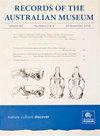A new subspecies of Philiris diana Waterhouse & Lyell, 1914 (Lepidoptera: Lycaenidae) from the Wet Tropics of northern Australia
IF 0.8
4区 生物学
Q4 ZOOLOGY
引用次数: 1
Abstract
Philiris diana Waterhouse & Lyell, 1914 from the Wet Tropics of northeastern Queensland was previously thought to be monotypic, being most closely related to Philiris papuanus Wind & Clench, 1947 from Cape York Peninsula, Australia, and mainland New Guinea. However, a new subspecies was recently discovered on the Atherton Tableland, which we illustrate, diagnose and describe as Philiris diana fortuna ssp. nov. It appears to be a narrow-range endemic, restricted to montane forest (750–1,090 m asl) and allopatric or parapatric from the nominotypical subspecies Philiris diana diana Waterhouse & Lyell, 1914, which is largely restricted to low to mid-altitude forests in the coastal escarpment in the Cairns-Kuranda district. Despite being separated by a minimum distance of only 20–25 km, the two taxa show substantial phenotypic differences in wing pattern elements, but negligeable differences according to the mitochondrial COI barcode region (mean p-distance = 0.28%). The habitat and biology of the new taxon are summarized, and likely historical processes driving divergence between upland and lowland populations of this species hypothesized.澳大利亚北部热带潮湿地区的一个新亚种(鳞翅目:石首蝶科)
来自昆士兰东北部湿热带地区的Philiris diana Waterhouse & Lyell, 1914年,以前被认为是单型的,与来自澳大利亚约克角半岛和新几内亚大陆的Philiris papuanus Wind & Clench, 1947年最接近。然而,最近在阿瑟顿高原上发现了一个新的亚种,我们将其描述为Philiris diana fortuna ssp。11 .它似乎是一种范围狭窄的地方性植物,局限于山地森林(海拔750 - 1090米)和非典型亚种Philiris diana (diana Waterhouse & Lyell, 1914)的异源或异源,主要局限于Cairns-Kuranda地区沿海悬崖地带的中低海拔森林。尽管两个类群之间的最小距离仅为20-25 km,但在翅膀图案元素上存在显著的表型差异,但根据线粒体COI条形码区域,差异可以忽略不计(平均p距离= 0.28%)。本文总结了该新分类群的生境和生物学特征,并对其高原种群和低地种群分化的可能历史过程进行了假设。
本文章由计算机程序翻译,如有差异,请以英文原文为准。
求助全文
约1分钟内获得全文
求助全文
来源期刊
CiteScore
0.90
自引率
0.00%
发文量
9
审稿时长
>12 weeks
期刊介绍:
Records of the Australian Museum, volume 62 was published in 2010, volume 63 in 2011. Monographic works of particular significance are published irregularly as Records of the Australian Museum, Supplements (ISSN 0812-7387).

 求助内容:
求助内容: 应助结果提醒方式:
应助结果提醒方式:


